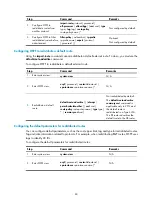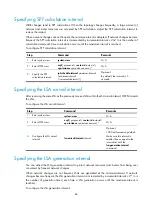
76
Step Command
Remarks
4.
Configure a virtual link.
vlink-peer
router-id
[
hello
seconds
|
retransmit
seconds
|
trans-delay
seconds
|
dead
seconds
|
simple
[
plain
|
cipher
]
password
| {
md5
|
hmac-md5
}
key-id
[
plain
|
cipher
]
password
] *
You must configure this command on
both ends of a virtual link.
hello
and
dead
intervals must be
identical on both ends of the virtual
link.
Configuring OSPF network types
OSPF classifies networks into the following types by the link layer protocol:
•
Broadcast
—When the link layer protocol is Ethernet or FDDI, OSPF considers the network type as
broadcast by default.
•
NBMA
—When the link layer protocol is Frame Relay, ATM, or X.25, OSPF considers the network
type as NBMA by default.
•
P2P
—When the link layer protocol is PPP, LAPB, or HDLC, OSPF considers the network type as P2P
by default.
The following are examples of how you can change the network type of an interface as needed:
•
When an NBMA network becomes fully meshed through address mapping—any two routers in the
network have a direct virtual circuit in between, you can change the network type to broadcast to
avoid manual configuration of neighbors.
•
When some routers in the broadcast network do not support multicast, you can change the network
type to NBMA.
•
An NBMA network must be fully meshed. If it is partially meshed, you can change the network type
to P2MP to simplify configuration and save network costs.
•
If a router on an NBMA network has only one neighbor, you can change the network type to P2P
to save network costs.
If two interfaces on a link are both configured as the broadcast, NBMA, or P2MP network type, they
cannot establish a neighbor relationship unless they are on the same network segment.
Configuration prerequisites
Before you configure OSPF network types, complete the following tasks:
•
Configure IP addresses for interfaces, making neighboring nodes accessible with each other at
network layer.
•
Configure OSPF basic functions.
Configuring the broadcast network type for an interface
Step Command
Remarks
1.
Enter system view.
system-view
N/A
2.
Enter interface view.
interface
interface-type
interface-number
N/A
















































